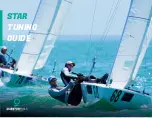
9-6
Section 9
Safety Equipment
OS 285
listing the Federal equipment requirements.
Also, check your local and state regulations.
The Coast Guard Auxiliary offers a “Cour-
tesy Examination.” This inspection will help
ensure your boat is equipped with all of the
necessary safety equipment.
The following is a list of the accessory equip-
ment required on your boat by the U.S.
Coast Guard:
Personal Flotation Devices (PFD's)
PFD's must be Coast Guard approved, in
good and serviceable condition, and of
appropriate size for the intended user. Wear-
able PFD's must be readily accessible,
meaning you must be able to put them on in
a reasonable amount of time in an emer-
gency. Though not required, the Coast
Guard emphasizes that PFD's should be
worn at all times when the vessel is under-
way. Throwable devices must be immedi-
ately available for use. All Pursuit boats
must be equipped with at least one Type I, II
or III PFD for each person onboard, plus one
throwable device (Type IV).
Visual Distress Signals
All Pursuit boats used on coastal waters, the
Great Lakes, territorial seas, and those
waters connected directly to them, must be
equipped with Coast Guard approved visual
distress signals. These signals are either
Pyrotechnic or Non-Pyrotechnic devices.
Pyrotechnic Visual Distress Signals
Pyrotechnic visual distress signals must be
Coast Guard approved, in serviceable condi-
tion and readily accessible. They are
marked with a date showing the service life,
which must not have expired. A minimum of
three are required. Some pyrotechnic sig-
nals meet both day and night use require-
ments. They should be stored in a cool, dry
location. They include;
•
pyrotechnic red flares, hand held or aer-
ial.
•
pyrotechnic orange smoke, hand-held or
floating.
•
launchers for aerial red meteors or para-
chute flares.
Pyrotechnics are universally recognized as
excellent distress signals. However, there is
potential for injury and property damage if
not handled properly. These devices pro-
duce a very hot flame and the residue can
cause burns and ignite flammable material.
Pistol launched and hand-held parachute
flares and meteors have many characteris-
tics of a firearm and must be handled with
caution. In some states they are considered
a firearm and prohibited from use. Make
sure you are careful and follow the manufac-
turer's instructions when using pyrotechnic
distress signals.
Non-Pyrotechnic Devices
Non-Pyrotechnic visual distress signals
must be in serviceable condition, readily
accessible, and certified by the manufac-
turer as complying with U.S. Coast Guard
requirements. They include:
Orange Distress Flag, day use only.
The distress flag is a day signal only. It must
be at least 3 x 3 feet with a black square and
ball on an orange background. It is most dis-
tinctive when attached and waved from a
paddle or boat hook.
Electric Distress Light, night use only.
The electric distress light is accepted for
night use only and must automatically flash
the international SOS distress signal. Under
Inland Navigation Rules, a high intensity
!
WARNING
FIRE/EXPLOSION HAZARD
Pyrotechnic signaling devices can
cause fire and/or explosion, death,
serious injury and property damage if
misused. Follow the manufacturer’s
directions in the use of these signal-
ing devices.
Summary of Contents for OS 285
Page 2: ......
Page 4: ...Operator Notes OS 285 ...
Page 14: ...8 Operator Notes OS 285 ...
Page 34: ...3 6 Operator Notes OS 285 ...
Page 46: ...4 12 Operator Notes OS 285 ...
Page 54: ...5 8 Operator Notes OS 285 ...
Page 62: ...7 6 Operator Notes OS 315 ...
Page 98: ...12 6 Operator Notes OS 285 ...
Page 104: ...A 6 Operator Notes OS 285 ...
Page 106: ...B 2 Appendix B Maintenance Log OS 285 Date Hours Dealer Service Repairs Maintenance Log ...
Page 107: ...Maintenance Log B 3 Appendix B OS 285 Date Hours Dealer Service Repairs ...
Page 108: ...B 4 Appendix B Maintenance Log OS 285 Date Hours Dealer Service Repairs ...
Page 109: ...Boating Accident Report C 1 Appendix C OS 285 Boating Accident Report ...
Page 110: ...C 2 Appendix C Boating Accident Report OS 285 ...
Page 111: ...Float Plan D 1 Appendix D OS 285 Float Plan ...
Page 112: ...D 2 Operator Notes OS 285 ...
Page 116: ...E 4 Operator Notes OS 285 ...
Page 117: ...Schematics F 1 Appendix F OS 285 Schematics ...
Page 118: ...F 2 Appendix F Schematics OS 285 ...
Page 119: ...Schematics F 3 Appendix F OS 285 ...
Page 120: ...F 4 Appendix F Schematics OS 285 ...
Page 121: ...Schematics F 5 Appendix F OS 285 ...
Page 122: ...F 6 Appendix F Schematics OS 285 ...
Page 123: ...Schematics F 7 Appendix F OS 285 ...
Page 124: ...F 8 Appendix F Schematics OS 285 ...
Page 125: ...Schematics F 9 Appendix F OS 285 ...
Page 126: ...F 10 Appendix F Schematics OS 285 ...
Page 127: ...Schematics F 11 Appendix F OS 285 ...
Page 128: ...F 12 Appendix F Schematics OS 285 ...
Page 129: ...Schematics F 13 Appendix F OS 285 ...
Page 130: ...F 14 Appendix F Schematics OS 285 ...
Page 131: ...Schematics F 15 Appendix F OS 285 ...
Page 132: ...F 16 Appendix F Schematics OS 285 ...
Page 133: ...Schematics F 17 Appendix F OS 285 ...
Page 134: ...F 18 Appendix F Schematics OS 285 ...
Page 135: ......
Page 136: ......
















































